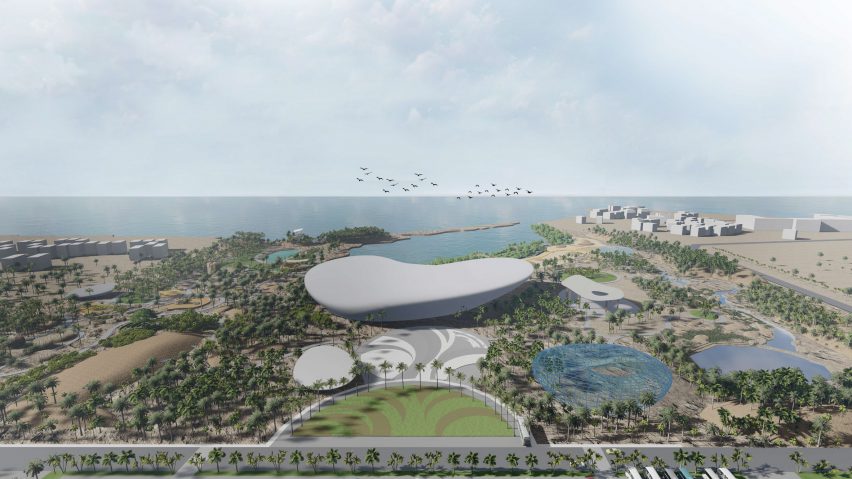
Ten landscape architecture projects by students at Clemson University
Dezeen School Shows: a museum in Egypt designed to conserve native plant life is included in Dezeen's latest school show by students at Clemson University in South Carolina, USA.
Also included is a design scheme that transforms classrooms into outdoor learning environments and a community centre built around a former industrial mill.
Clemson University
Institution: Clemson University
School: School of Architecture
Course: Master of Landscape Architecture
Tutors: Hala Nassar, Lara Browning, Hyejung Chang, Mary G. Padua, Matthew Nicolette, Paul C Russell, Thomas Schurch and Hannah Slyce
School statement:
"Clemson University's Master of Landscape Architecture (MLA) is a nationally recognised, STEM-designated professional degree accredited by the Landscape Architecture Accreditation Board (LAAB).
"The MLA programme at Clemson University prepares students with the knowledge, skills, techniques, theories and technologies to become an effective contributor to the landscape architecture profession.
"As the only landscape architecture program in the state of South Carolina and one of the top in the nation, the MLA program offers a balance of professional skills and theoretical and historical knowledge that prepares our students for professional practice immediately upon graduation.
"The combination of rigorous education, research engagement at a Tier 1 research institution and practical knowledge provides a strong foundation for different career paths, including professional practice in a firm, research, or teaching at an academic institution.
"An internationally-renowned and award-winning faculty lead the program with broad expertise in urban and community design, health and design, ecology, environmental sustainability and design implementation.
"Throughout the program, students are engaged in design and research at local and global scales, focusing on contemporary issues such as climate change, sustainability, social and environmental justice and resilient communities."

The Grand Canal Eco-Resort and Destination by Frances Sledge
"The Grand Canal Eco-Resort and Destination are located in the north of an Eco-Tourism Zone along the Grand Canal in the city of Yangzhou, China.
"A UNESCO World Heritage Site, the Grand Canal is the longest human-made artificial canal or river in the world, extending over 1,014 miles.
"The ancient parts of the canal date back to the 5th century BC, but some sections of the canal were first connected during the Sui dynasty (581 to 618 AD).
"The Grand Canal served as the main artery between northern and southern China and was essential for the transport of grain to Beijing.
"Industrial land use and transportation resulted in increased levels of water pollution affecting the flora and fauna along the Grand Canal.
"The project encourages low-impact forms of tourism, including camping, hiking, kayaking, fishing, adventuring and botanical activities, spread over 930 acres of designed environment and a 111-acre linear boardwalk over the wetland.
"The goal of this project is to honour native ecosystems, cultures and communities while bringing pride and revenue to the city of Yangzhou, China."
Student: Frances Sledge
Course: LARC 8520: Advanced Urban Design
Tutor: Hala Nassar
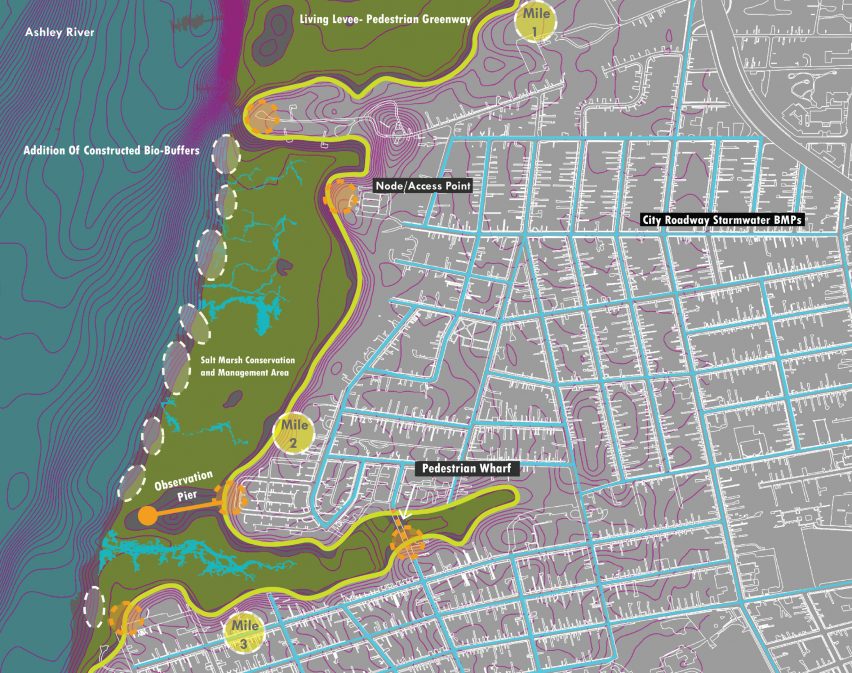
Halsey Creek: Reef Restoration and Levee Trail by Chelsea Preciado
"Water has always been a primary focus for Charleston, South Carolina. This resource has given the city its historic character while also supplying a form of commerce and transit.
"In recent years, however, conversations about water have turned toward public safety, management and security as flooding events and rising sea levels pose increased threats.
"This project focuses on a resiliency plan for the Halsey Creek watershed, employing a three-step process for water management in the landscape.
"Step one addresses stormwater in the urban environment, step two protects the marsh and step three stabilises the living shoreline."
Student: Chelsea Preciado
Course: LARC 8520: Advanced Urban Design
Tutor: Robert Hewitt
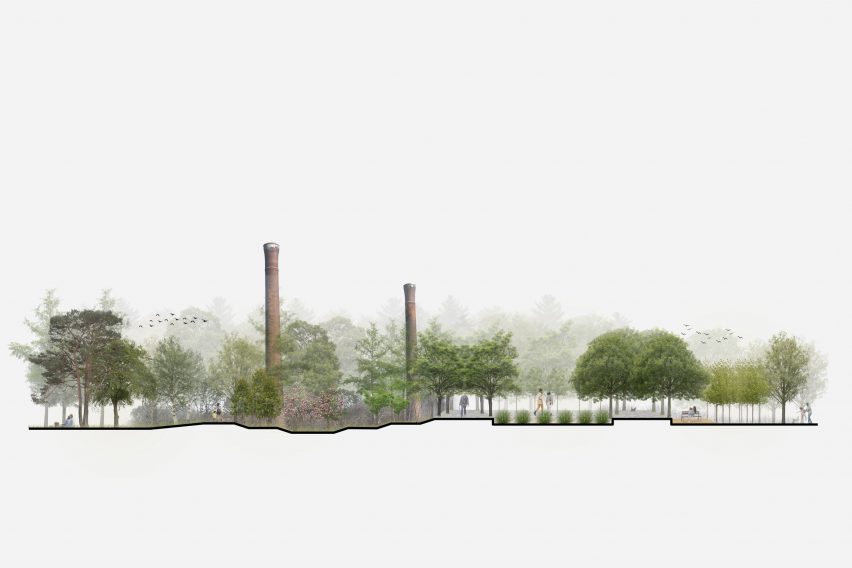
Poe Mill Village Green by Devon O'Geary
"Poe Mill Village Green is an open space for community gathering, passive recreation and relaxation.
"Situated on the site of a once-thriving cotton mill, this new park offers lush areas of vegetation, open lawns for picnicking and play, and a strong connection to the Swamp Rabbit Trail.
"The site is meant to be experienced by walking. Visitors to the park will experience various 'rooms', or pockets, of vegetation, with views of the two landmark steam stacks.
"Each room is categorised with a prominent tree species found in South Carolina. Not only does the park offer an educational opportunity for viewers to learn more about native vegetation, but it also pays tribute to the now-dismantled mill.
"Although the mill burned down in 2003, the saltbox homes of the mill village still stand, as does the community built by the industrial manufacturer."
Student: Devon O'Geary
Course: LARC 8920 and LARC 8500
Tutor: Paul Russel
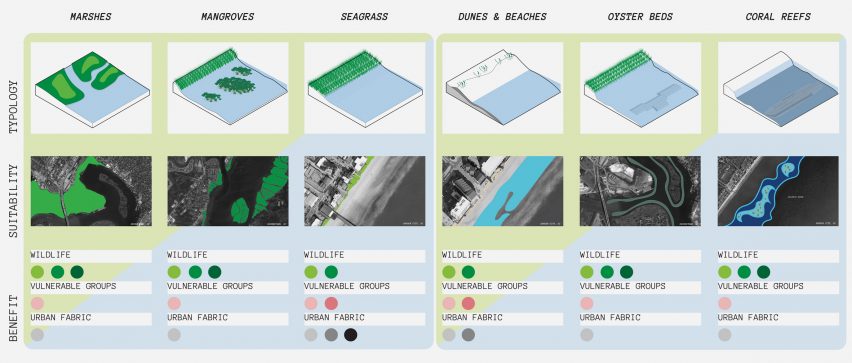
Coastal Urban Flood: Designing for Resilience in Vulnerable Communities by Hannah Slyce
"As we progress further into the Anthropocene age and continue to rely on fossil fuels for energy, the rapidly changing climate will only get worse.
"We must shift to a realm of thinking that progresses away from reversal of damage but to mitigation of effects.
"This project evaluates a small coastal urban town in the low country of South Carolina, which experiences seasonal flooding due to the combination of tidal fluctuations, sea-level rise and the climate-induced increase in frequency and intensity of storm events.
"The effects of these flood events are felt all over the city, but the impact is felt more intensely by vulnerable groups, including low-income communities and people of colour.
"This research sets out a flood mitigation plan that utilises the landscape to protect the urban fabric and restore wildlife habitat while focusing on vulnerable groups and addressing environmental injustices."
Student: Hannah Slyce
Course: LARC 8920: Terminal Project
Tutor: Hyejung Chang
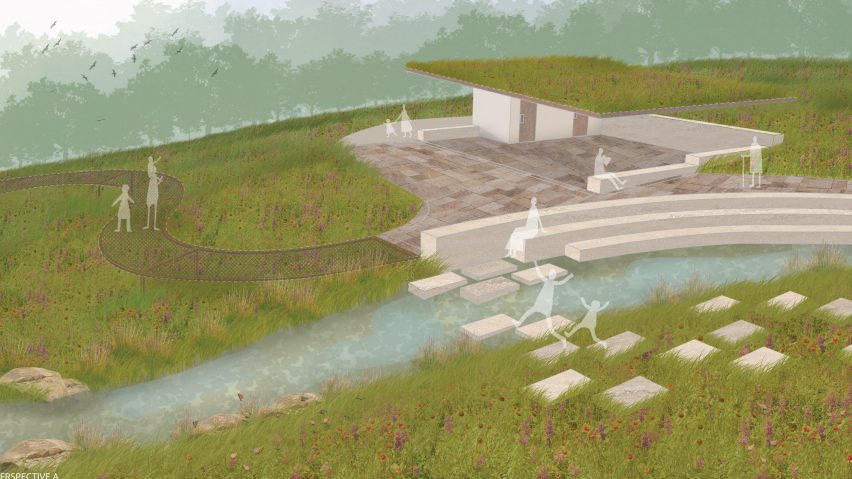
Lake Issaqueena Ecological Park by Maggie Gaston
"Lake Issaqueena Ecological Park develops an under-utilised and ecologically underperforming site on the shores of Lake Issaqueena in Upstate South Carolina into a productive and immersive experience for the enjoyment of the community.
"The existing site – through years of neglect – has been overrun by invasive plant species and has developed eroding banks and an inaccessible path network.
"This design promises to restore and enhance the ecological systems while sensitively layering pedestrian programmes for the purpose of enjoyment, relaxation and education.
"Ultimately this project serves as a primer to improve the ecology and experience of other sites on Lake Issaqueena or similar bodies of water."
Student: Maggie Gaston
Course: LARC 8430: Interdisciplinary Design and Research
Tutor: Matt Nicolette
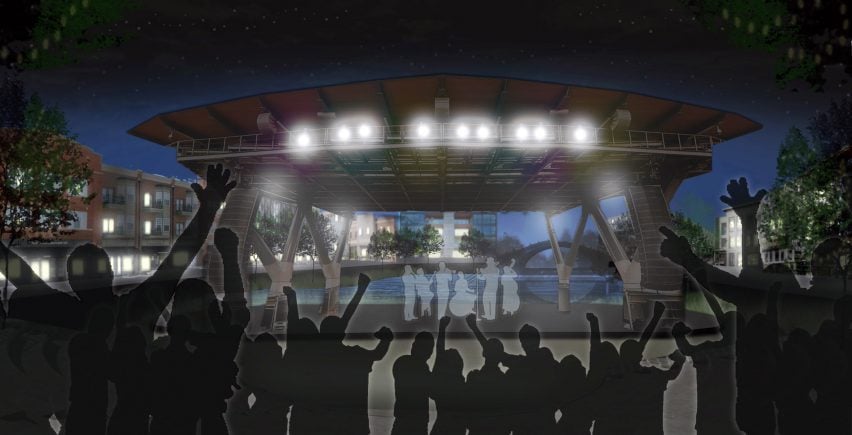
Yangzhou's New Medical District: Restoring Urban Health and Community by Molly Foote
"This medical campus design focused on the concept of Eco-Regenerative Healthy Corridor, which was inspired by the Grand Canal in the project city of Yangzhou, China.
"The intertwining of health, wellbeing and rejuvenation is explored through a diversely programmed masterplan.
"Among the research, residential, hospital, manufacturing, and education sectors, a central corridor comprised of the ecological botanic garden, the regenerative urban core and the healthy community fitness centre showcases the potential of a healthy environment, a healthy city and a healthy community."
Student: Molly Foote
Course: LARC 8520: Urban Design-World Design Studio
Tutor: Hala Nassar
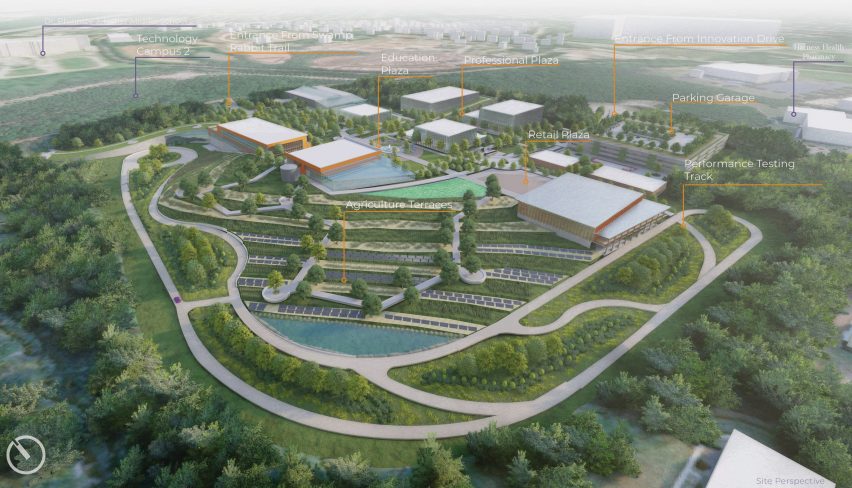
Energy Innovation Park CU-ICAR by Rachael Jackson
"The project aimed to create a masterplan for Clemson University International Center for Automotive Research (CU-ICAR's) Technology Neighborhood 3, focusing on automotive engineering and going beyond sustainability to regenerative design.
"The core concept was regenerative design, aligning with CU-ICAR's commitment to technological advancement and reducing its carbon footprint.
"The Energy Innovation Park encompasses corn fields, algae ponds and a solar farm, researching various biofuel generations to fuel both the site and CU-ICAR's vehicles.
"Additionally, it collaborates with the net-zero buildings on-site to generate power and gather stormwater and greywater for irrigation in the agricultural fields.
"This existing campus lacked green space, nature trails, and architectural diversity, primarily featuring monochrome brick or concrete materials."
Student: Rachael Jackson
Course: LARC 8520: Advanced Urban Design
Tutor: Hala Nassar
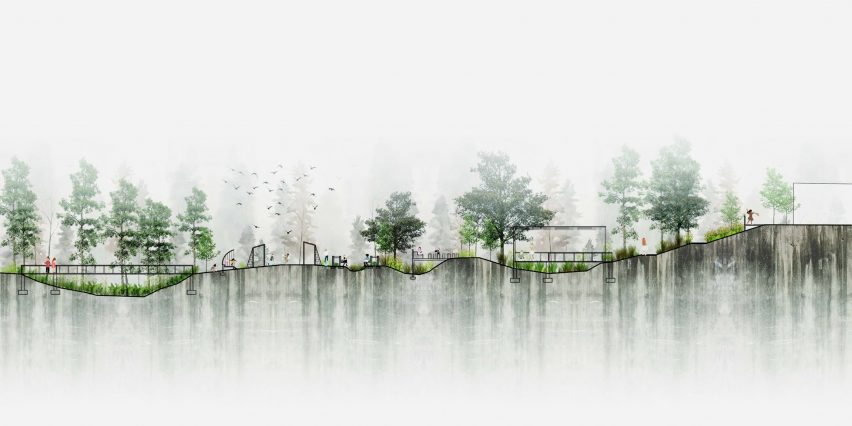
Equal Play by Hannah Smith
"Women occupy the built world just as much as men, yet only 30 per cent of practising landscape architects are women – this suggests that our built world is inherently gender biased.
"This project's focus is to design learning spaces that promote gender equity and provide opportunities for success for all genders.
"This can only be achieved if spaces are designed by those who are using such spaces.
"This does not suggest that only women can design spaces for women, but women need to be a part of the design process and obtain decision-making power – this starts with providing environments that welcome and support all genders.
"Through the understanding and implementation of gender-sensitive strategies, gender equity can be achieved within early childhood education play environments to create engaging educational environments that encourage equity in the profession of landscape architecture."
Student: Hannah Smith
Course: LARC 8920: Terminal Studio (Design), ARCH 6990: Design Justice (Research) and LARC 8500: Graduate Colloquium (Research)
Tutors: Paul Russell, Clarissa Mendez and Hyejung Chang
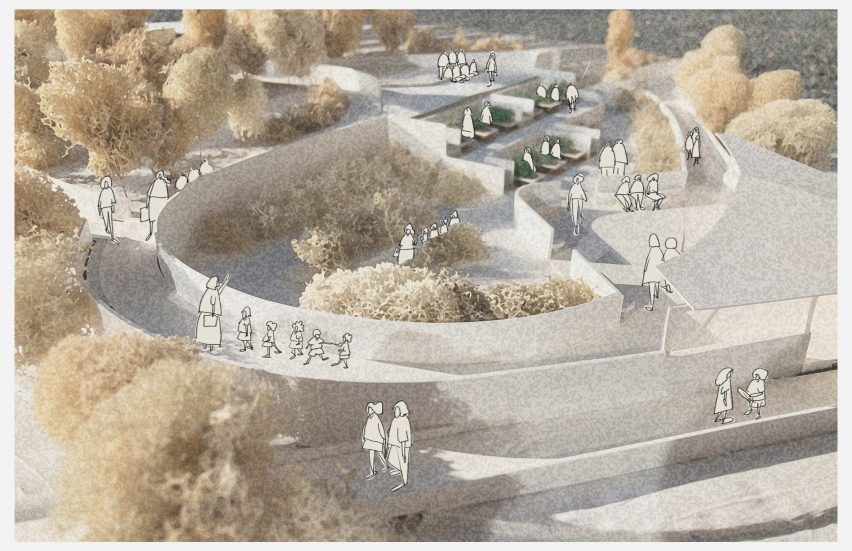
Learning in the Landscape by Tamaki Inahata
"Learning in the Landscape provides an educational environment that transforms the conventional classroom into an immersive experience in nature.
"Its mission is to create a distinctive educational system for the community to be used by public and private schools as well as home-schooling cooperatives.
"This design offers unique opportunities for students who learn conventionally as well as those who have difficulty in a traditional academic setting.
"When the site is not in use, the community can enjoy the project as a stage to experience nature. Hopefully, this innovative typology will become a model for alternative strategies in education."
Student: Tamaki Inahata
Course: LARC 8430: Interdisciplinary Design and Research
Tutor: Matt Nicolette

Droplet in the Desert - Naama Bay Nature Museum, Namma Bay, Sharm El Sheikh, Egypt by Xiao Xu
"The Nature Museum is designed as a new landmark in Sharm El Sheikh, Egypt, growing unique plants and landscapes and presenting the city's natural history.
"The colossal museum will show all of the native plant species of Egypt in a series of created, naturalistic habitats, from the desert landscape to the vast mangrove habitats.
"Sharm El Sheikh is a typical desert landscape city – to provide a new sensory experience, this site is designed as a wadi landscape, which refers to a dry (ephemeral) riverbed that contains water only when heavy rain occurs.
"With the Droplet of the Desert concept, the Namma Bay Nature Museum will allow visitors to experience the flora and vegetation of Sharm El Sheikh while learning about diverse plant species, rich natural ecosystem and legendary hospitality of the country."
Student: Xiao Xu
Course: LARC 8520: Advanced Urban Design
Tutor: Hala Nassar
Partnership content
This school show is a partnership between Dezeen and Clemson University. Find out more about Dezeen partnership content here.